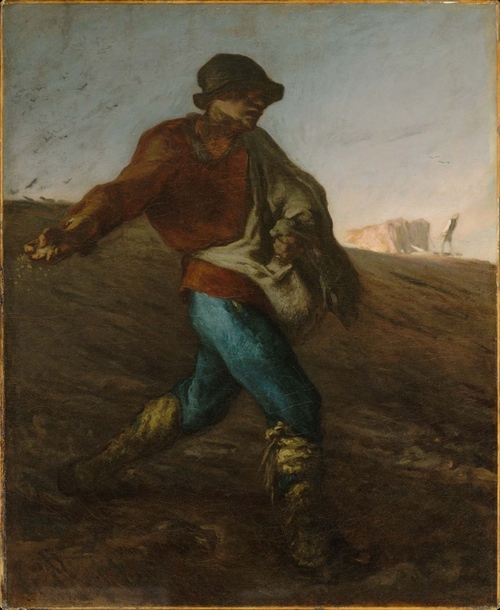The Sower was one of Millet’s early paintings conceived and painted at Barbizon. His earlier versions were said to have been more reminiscent of his Normandy home than of Barbizon. The originals showed more of a man of Greville with a proud and series step in the midst of a flock of crows there to sample the grain. Later versions would become more representative of Barbizon; the man is said to be almost more Parisian.

Millet submitted The Sower to the Salson of 1850 at the Palais Royal. It was submitted along with “The Sheaf-binders” but it was “The Sower” which would be copied by students and reproduced in lithography. Theophile Gautier provides an apt description,
“”‘The Sower,’ by M. J.-F. Millet, impresses us as the first pages of the ‘Mare au Diable’ of Georges Sand, which are about labor and rustic toil. The night is coming, spreading its gray wings over the arth; the sower marches with a rhythmic step, flinging the grain in the furrow; he is followed by a cloud of pecking birds; he is covered with dark rags, his head by a curious cap. He is bony, swart, and meager, under this livery of poverty, yet earth, with a superb gesture, the bread of the future. On the other side of the slope, a last ray of the sun shows a pair of oxen at the end of their furrow, strong and gentle companions of man, whose recompense will one day be the slaughter-house. This is the only light of the picture, which is bathed in shadow, and presents to the eye, under a cloudy sky, nothing bu newly plowed earth. Of all the peasants sent to the Salon this year, we much prefer “The Sower”. There is something great and of the grand style in this figure, with its violent gesture, its proud raggedness, which seems to be painted with the very earth that the sower is planting.”
“The Sower” is a work that illustrates one of my pet peeves about the art world – trying to turn everything into some deeper sort of meaning. Sensier, Millet’s biographer and great friend, wrote that during Millet’s lifetime some were trying to ascribe political connotations this work. It was said that the sower was cursing the rich because he was flinging the grain, with anger, towards the sky. Some also tried to turn Millet’s works into social weapons. Sensier, in his biography, Jean-Francois Millet, peasant and painter, said the Millet often said, “My programme is work. ‘Thou shalt gain thy bread in the sweat of thy brow’ was written centuries ago. Immutable destiny, which none may change! What every one ought to do is to find progress in his profession, to try ever to do better, to be strong and clever in his trade, and be greater than his neighbor in talent and conscientiousness in his work. That for me is the only path. The rest is dream or calculation.”